It’s Spring! Where Have the Parrots Gone?
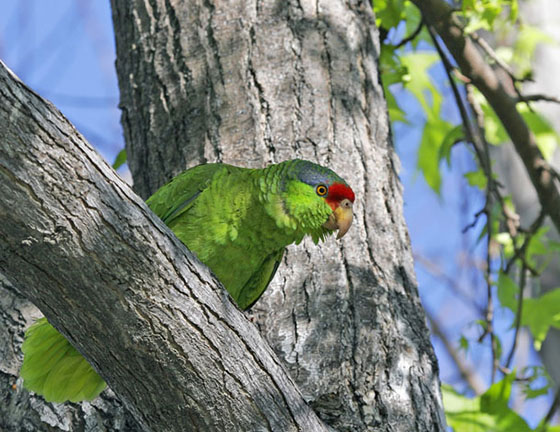
The lengthening days of winter give the first sign that spring is slowly approaching and mother nature signals, it is time to prepare.
Lifetime and first-time mates alike, break from the safety of their flock leaving the single birds and the juveniles behind in search of the ideal place to raise this year’s young. With mated pairs absent, the flock becomes only a portion of what it once was.
Those with years behind their union may return to their ideal place year after year, others may return to their choice spot only to find their ‘perfect place’ trimmed to ruins or worse yet — completely gone. For those birds and first-time mates, the search for an appropriate nesting place may become long and tedious. For some, their search will lead to parts unknown, for others…no appropriate place will be found and their expedition may continue through the year, missing this nesting season completely.
Once a suitable location is found, a mated pair will spend months making sure all the other parrots know they have found “their spot” and an invisible “NO TRESPASSING” zone will be established. Highly protective of this area, they will defend it not only from invaders and those they feel a threat, but also from their own flock-mates, who may attempt a takeover. Should another parrot enter their forbidden zone, all hell may break loose. Now vulnerable, yet brave, it is here they will raise their young.
Spring has arrived and mama parrot is ready to lay her eggs. She will do so with unbelievable dedication and patience, but it is papa parrot who will ensure she succeeds. He will provide her protection, her early warning system and her food supply until she is ready to emerge from the closed-in space they have chosen.
For almost a month, mama parrot will sit on her eggs turning them frequently and tending to their incubation. She will break only for a quick meal furnished by papa parrot and back inside she goes. It is an abrupt change from her once active lifestyle, but she is fully prepared for the task.
With the eggs beginning to hatch, her job escalates to constant care. Her limp and naked little ragdolls need her more than ever — she must keep them warm and fed — and her once powerful beak has now become a soft and gentle tool for their care.
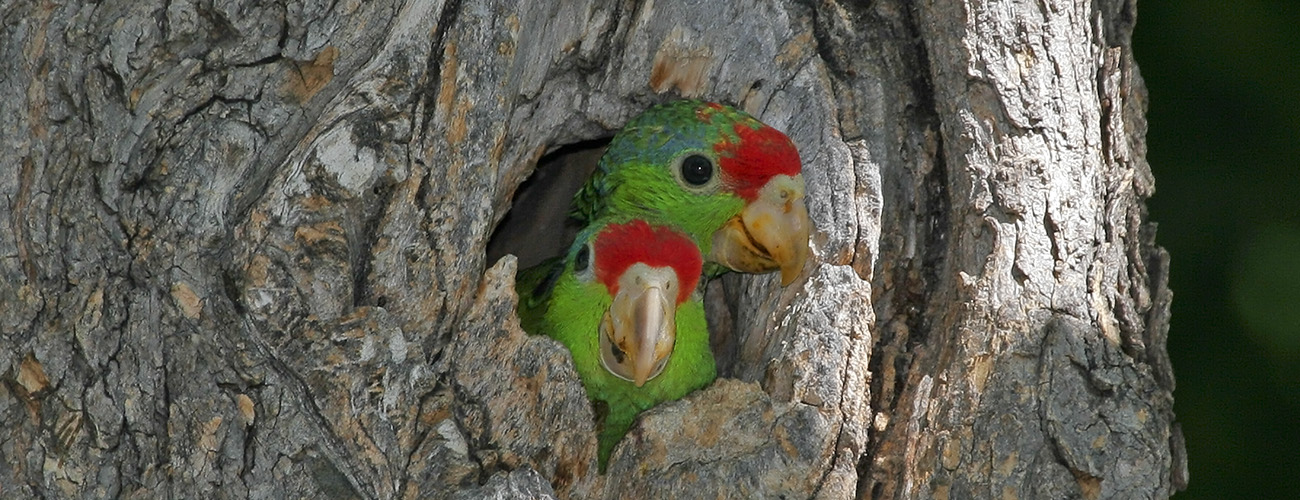
Once chicks are fully feathered and developed enough not to need the constant care and warmth of their mother, she returns to her role as the devoted mate and partner. The babies have inched her out of the nest with their rapid growth and soon the nest will be too small for them as well.
Leaving her young is never easy, but it is time and in preparation for the days ahead, they must bond with their father for he will become their primary provider once they leave the nest. In order to establish this bond, dad will begin to share in the responsibilities of feeding his young.
Several days before fledging, mom and dad will lessen their feedings. Their once well fed, pudgy little chicks must now lose weight and be light enough to fly. For those little chicks who are hesitant to fly, lessening the feedings can also serve as motivation to coax them out of the nest. An apprehensive little fellow will sometimes need a reason to follow his parents. They are his life-line and his desire to be fed will drive him to fly.
Curiosity toward the outside world is building and chicks begin poking their heads out of the nest to catch a glimpse of the outside world. It is a treacherous world and the sounds they have been hearing for months must now be associated with movement and objects. Curious though they may be, they have already learned to duck back into the nest and away from anything they might consider a possible threat.
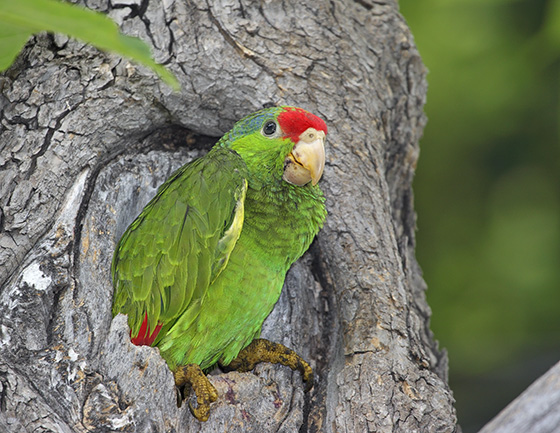
As fledging day approaches, a babies’ focus on his parents becomes extremely important. Without fail, he has learned his parent’s vocalizations and while other parrots in the vicinity appear to use the same calls, he can keenly distinguish those of his parents and will respond only to them.
The day has arrived and it is time for the eldest to spread his wings. He patiently peers from the nest awaiting his parent’s arrival and within minutes of their return, climbs to the opening of the nest — he is ready to fly.
It is unknown why, but the anticipated fledge of a youngster may sometimes become a group event where parents bring along other adults as helpers.
Quietly communicating with his parents, the youngster receives the “okay” and he takes off toward the sky with his parents closely behind. On the occasion where others are present, they will all swoop down and surround him, collectively guiding him to safety.
His wings are weak but his spirit is strong and he will fly until he can fly no more. His parents must know where he is at all times or he could be lost. Without their expert training, he could fall prey to a dangerous world very quickly. At the end of his first flight he is exhausted, yet proud. He has successfully completed his maiden flight and is well on his way to becoming a fully fledged parrot.
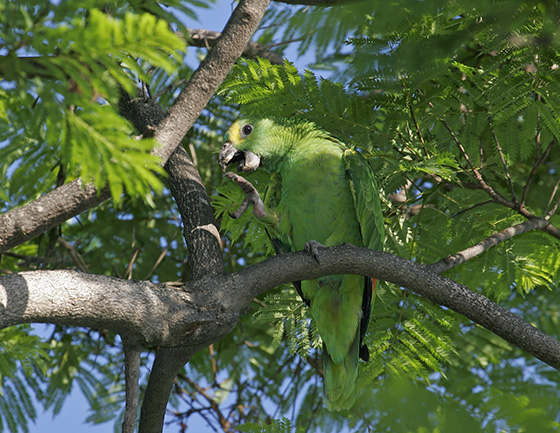
He must now gain strength to keep up with the flock and this will take time. He also must learn balance, agility and the power of his incredible beak and feet. His training has begun, but for the parents, they must leave him alone and hidden in the camouflage of the trees while they return to care for the chick(s) remaining in the nest. This is a tricky time at best. Caring for babies in different locations takes planning and coordination — and for days, can mean that little ones are left completely alone for hours on end. Despite their young and tender age, they seem to understand that they must stay put with all the patience they can muster. Yes, their birdie training has begun, but until the family can be reunited as a whole, they will share their parents’ attention with the sibling(s) they left behind.
Each chick is an individual and while some take to flight in an instant, others are cautious and shy. There are those who, no matter how hard they try, just don’t grasp the concept of flight. For these young birds, their first flight takes them nowhere, and they land right where they shouldn’t be — directly on the ground and in the throes of danger. Here they must face the greatest challenge of their lives and all at a very young age — for these babies “luck” now becomes the key. Life has presented a great test for this young parrot to survive, but with patient parents and luck on his side, he will ultimately succeed. This could take days and his devoted parents are up to the task — they will not desert him under any circumstances, even though their absences may be long and sporadic in order to care for and train his sibling(s). As soon as his ability to fly takes hold, the trees will provide a much safer haven.
Often newly fledged siblings are strategically hidden a distance apart to increase their chances of survival should something jeopardize their safety.
Once all babies have improved their flying skills which could take a couple of weeks, it is time for this family to return to the flock. Though the parents have each made periodic returns, for the babies, this is a brand new experience. They have instantly become members of the flock and while they have not yet learned to feed themselves, weaning is just around the corner and their intense training has begun. Remaining close to their parents at all times, they quickly learn there is safety in numbers and as the flock goes, so goes the babies.
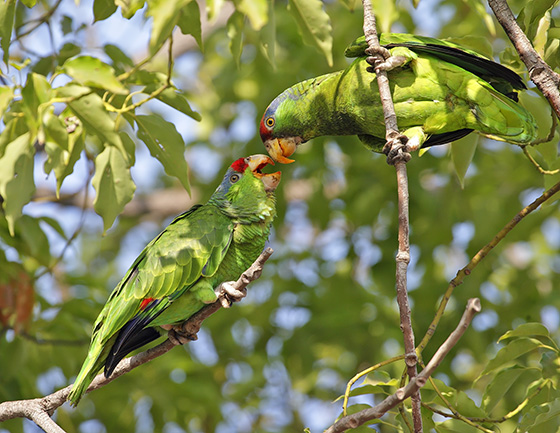
As familiarity with the flock is established, a large group of parents bring their babies together in what can only be called “Parrot Pre-school.” It is here the young parrots become acquainted with others their age and their flock socialization begins. It is a time of wonder and discovery. For these little ones, being a bird is now exciting and fun! With the others their age, they learn to navigate their new world chasing each other, pouncing in the trees, hanging from the branches and the wires and play-fighting — all under the watchful eyes of their parents. It is “the beginning of the end” of the dependence on their parents which is still months away. It is here also, that their attempt to learn the flock vocalizations, at times, can become downright comical. Testing their voices, the most unusual of sounds can be heard — some not even close to those they will ultimately perfect.
Vocalizations, as well as body language will become a huge part of their social interaction with the flock.
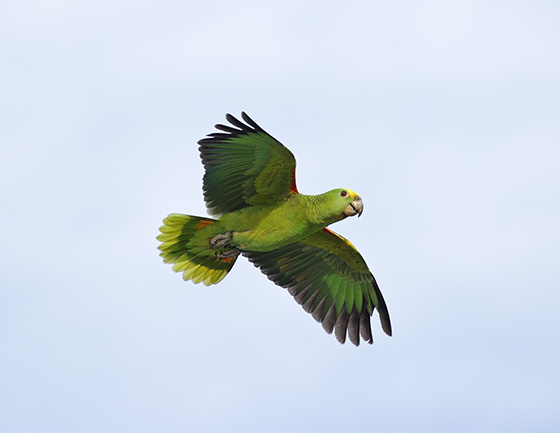
They must learn with accuracy, the meaning behind each call. From vocalizations of friendship and kindness, to those proclaiming territorial rights, to calls of impending danger — it is a language all its own. Among this flock of six different Amazona species, each with their species specific calls, some will learn calls that bridge the species barrier, some will become bilingual and use another species’ calls when addressing that species, some will simply listen intently – but, all will understand.
